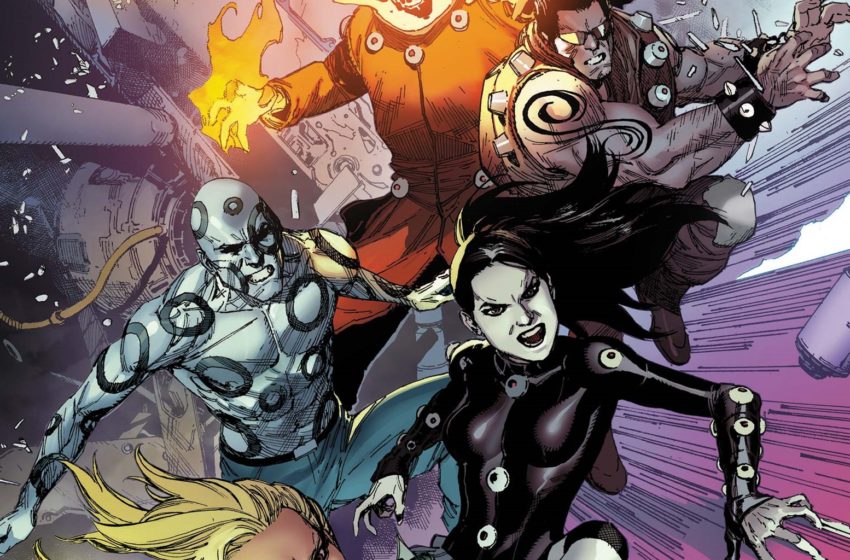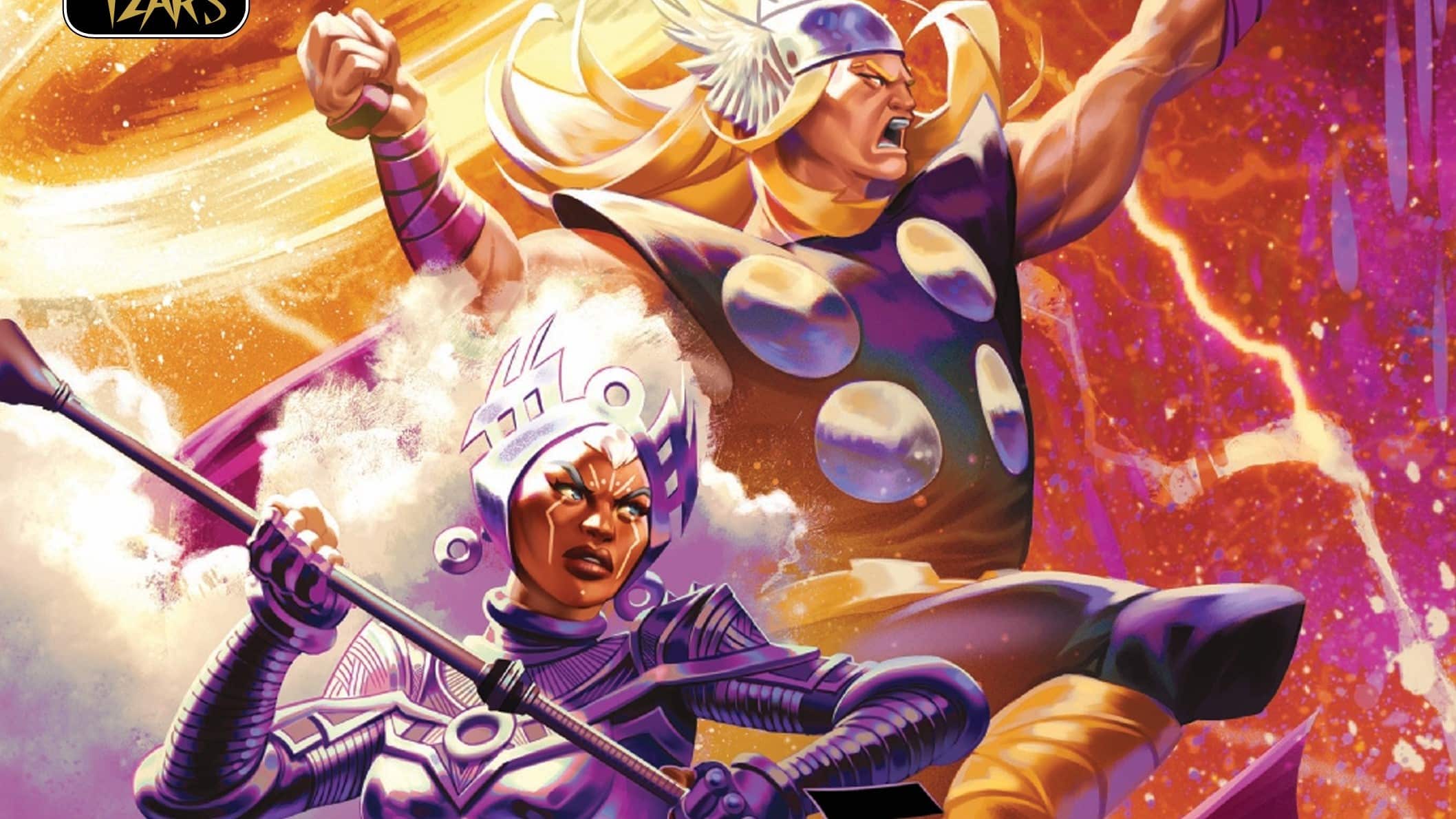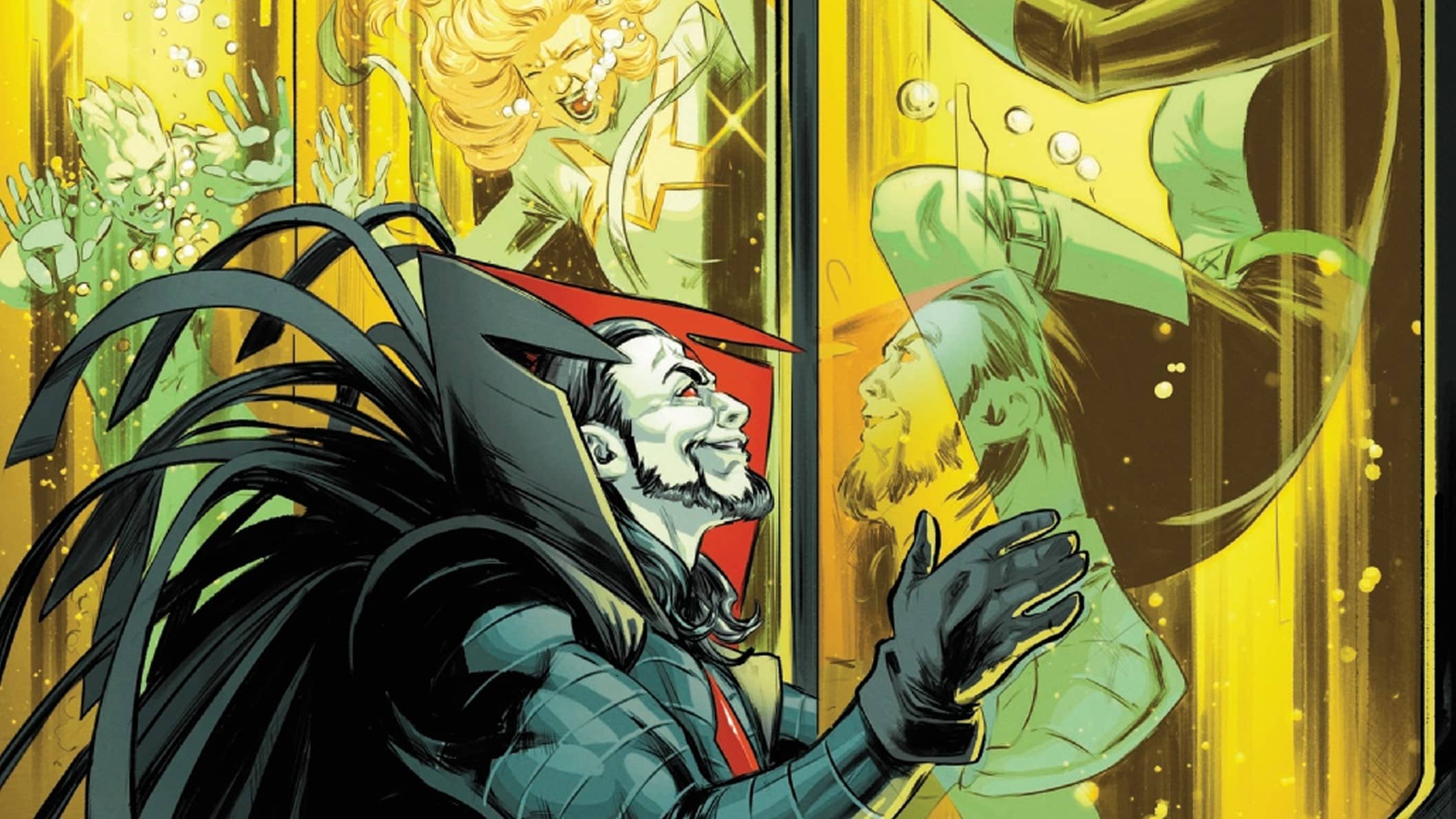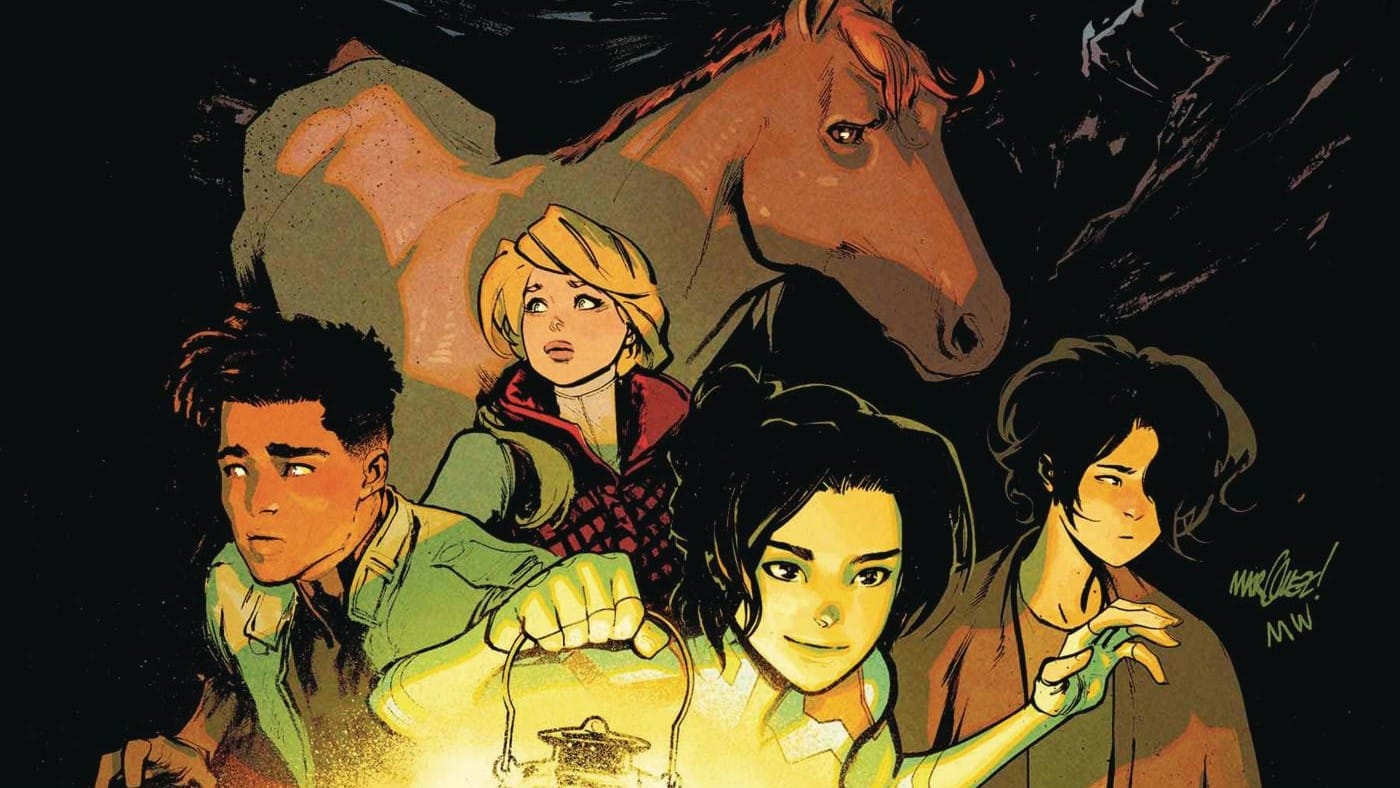Can Synch, Wolverine, and Darwin survive the endless span of hellishly stretch time in the Vault? We’ll dig into X-Men #19 written by Jonathan Hickman, art by Mahmud Asrar, colors by Sunny Gho, and letters by Clayton Cowles.
Chris Eddleman: Rob, we saw a very decompressed incursion into the Vault in our last issue, and I’m hungry for centuries of horrifying isolation. Luckily for my morbid appetites, I think that’s what we’re in for in this issue as we are promised an escape from the Vault. And much like my escape from Vault soda after it’s discontinuation in 2011, I don’t think we’re going to come out of this unscathed.
Robert Secundus: This is it. After over a year we’re finally, finally going to see what happened to the Vault Team. I’m ready for it.
Like Sands Through An Hourglass, So Too Are the Eons Spent in the Vault

CE: So our last issue, as I stated above, was a short little decompressed issue, where our trio enters the Vault and encounters its Children, a posthuman threat from yesteryear, brought into prominence by this bold new era in X-Men comics. It ended on a slight cliffhanger, as a massive explosion ripped through our crew. But instead of starting with that, we start with a three-sectional timeline graphic. I was immediately excited to see this one, Rob. I feel like a lot of the graphs have become dossiers or little journal entries, which I’ve started to find kind of lazy in approach. But a timeline? Well that’s House of X #2 vibes. I practically did a fist bump in the dentist’s waiting room. How about you? Thoughts on this graph?
RS: I definitely prefer the data pages that are cool visually based data pages. I think it’s awesome when the data pages really take advantage of not only the unusual rules of this line of comics, but remember to take advantage of the visual medium of comics. The data pages in this issue help pace it, help us keep track of the characters, help communicate in montage their centuries spent here— but the best moment for me in the issue is when the lines shift. That’s what a data page at its best can do— give the reader some simple, abstract representation of what’s happening that still evokes some emotion.
We see the lines stop running parallel, and before we read what happened, we go oh sh— just based on an angle. You know, when we first started these back with HoXPoX, I tried to read as much of Hickman’s independent work as I could. It’s so interesting seeing how he refines techniques and approaches that, at the start, don’t work great. Pax Romana is a series that functions a lot like this Vault arc. It’s big concept scifi that plays with time and time scales. It skips huge chunks of story and conveys timelines of characters at a distance. But it does so to its detriment— Pax Romana feels weakened for its abridged storytelling and accelerated timelines. This arc feels strengthened for it. Part of that is the strong emotional core (which we’ll talk about later), but part really is just the, I think, stark, simple clarity of these data pages.
CE: It did really remind of Pax Romana. Those “No Dark Ages” timeline additions in Pax Romana definitely felt like somewhat of nonaddition, especially when all the cool futuristic stuff was only experienced in an afterthought endnote.
Another thing I particularly liked with this recurring graph was how it DIDN’T actually use an exact framing of years. Events are simply ordered chronologically, and even when chunks of timeline break off, we still don’t get any sense of scale. But even that gives it is a sense of massive, unknowable scale. I looked back at X-Men #5, in which at some point during their Vault excursion, Xavier tells Cyclops that the team has been missing roughly five hundred and thirty seven years. We never get an exact measure afterwards, and even in this issue time is supposed to flow at not only a different, but a variable rate.
RS: That uncertainty is key to our experience of exponential time in this issue. It’s all subjective, all conveyed as a result of Synch’s narration or as a translation of his thoughts. It both makes the events feel more massive and more personal.
CE: I think this simple ordering of events rather than a strictly scaled timeline feels like a culture’s oral traditions, in which events were stated in order but without necessarily attention to scale. Oral traditions in some cases have been shown to be accurate for over 400 generations, describing landmarks and features from millennia ago. Just so, Synch’s account (later psychically maintained, but not written down) is used to describe events within the Vault as sequential and descriptive but, not with the most exact scaled timeline. It just doesn’t feel important here. The only importance is eternity.
Love, Endlessly

RS: As we said above, this issue works because it’s not an issue about time. It’s about Darwin, Wolverine, and Synch, but especially about the relationship between the latter too. I’ve never read Generation X in full [Ed. note: thanks, Marvel Unlimited, for not uploading one of the most beloved X-Men series!], so I had no prior affection for Synch’s character— but now I love him, and I can’t wait to see what happens with him next. His passion, his love for Laura, and by the end of this issue, his hope, his certainty— I find it all incredibly compelling.
CE: My love for Synch started very personally because he and I are both from Missouri, which is a silly reason to start loving a character but what can you do? But what his (somewhat small overall) amount of appearances convey is an incredibly talented capable person, and this issue really helped with that.
We’re even getting a story told over his three appearances in this era, in which he was resurrected kind of lonely, as many of his friends had lived years and years since his death, and then his willingness to assist in this mission, and now mirror-like his own experiences of years and years. His is our central narration, and we get a nice story told where his father had explained to him that love was being willing to die for someone, but as he spends long, long years in the Vault, he begins to think his father was too human. Synch believes that living for someone is a true expression of love. That’s a very mutant (at least in our current era) belief. Dying is easier than having hundreds of years of affection for someone. I like what you said about his hope.
At the end of this issue, when the woman he loved for centuries growled at him, not having any memory of their eternity together, he doesn’t despair— he smiles. I love that so much. We get this story of brutal survival, having to sneak around for eons, constantly fighting, losing limbs, and in poor Darwin’s case, being annihilated on the molecular level. I think that could have easily been played for more despair. And it was heartbreaking! But the era we’re in doesn’t wallow in misery, and that made for a satisfying story.
RS: The one thing I feel it lacked— and I’m not sure there was room for this, that it would be possible to address this— was time with Darwin. I wish we’d seen a bit more of Synch and Darwin’s own relationship. Synch must have cared deeply for him, must have loved him too.
CE: Yeah, Darwin always seems to unfortunately not get enough material. And even though Asrar and Gho get to bring their absolute A-game with tons of character designs and cool architecture, I would have liked to see a bit more weird adaptation stuff for them to get to work with. Maybe too much for one issue as you said but, it would have been nice to see.
Posthumanism, Huh?

CE: So another point I really would like to address is how throughout all of their appearances, the Children of the Vault are incredibly haughty about how mutantkind is so much more inferior to them, blah blah blah. As the real posthuman threat currently encountered by mutants, I suppose a supremacy complex is somewhat necessary. But even after all of that talk and a time dilation bubble in their TARDIS-esque city, they still can only get so far in terms of their own guided evolution. They had to do a little theft, in the form of stealing the genetic material of poor Darwin.
I found this kind of horrific, to be honest. Stealing someone’s body is definitely a time honored tradition in comic book silliness but, destructively deciphering it and using it as raw material? Boy that sure is unsettling. But in some ways Synch did a bit of the same, but his powers are sympathetic. To use a very outdated Heroes parlance, he is the Peter Petrelli to the Children’s Sylar. Is this jazzing with you, or was this just a weird thing to me?
RS: I think it’s supposed to be very disturbing. Asrar’s time-warping, hateful City brings to my mind a few traditions of sci-fi horror, I think; I get Metropolis, Dark City, and The Matrix vibes from it, as well as Nimrod’s test tube mutant preserves in Powers of X. It’s the horror of not just being captured by your enemy, but of being absorbed by them. It’s running in fear from a hostile environment, and then that hostile environment consuming you, making you a part of it. Maybe some Shining vibes as well. But I think it’s also doing a few things thematically here. As you pointed out, there seems to be a limit on technology’s advancement of humanity. It requires mutant DNA. Without defining the terms of the mutant metaphor too strictly, I think we can say we have a story of an oppressor that preaches its superiority even while it relies on the group it claims to be inferior. We have a story about an oppressive power using something which opposes it; recuperation is, I believe, the technical term. Appropriation might also be a term useful to us here, as the oppressive culture makes use of something from the oppressed. But it’s all made visceral by being reduced to one person, one character loved by our narrator being violated in this way.
CE: The fact that we don’t even get the Children’s take on it is also telling. They had to steal from concentrated evolution, something that they don’t possess, in order to better themselves, and the only dialogue we get from them is a taunt that they’re going to wipe every mutant from the planet. The theft isn’t even acknowledged, and even if they aren’t textually ashamed, their actions seem to indicate it.
To drift a little bit to some classic speculation, the Children might be seen as a proto Homo novissima (our blue posthumans from Powers of X). This makes me wonder if instead of their stated preservationist reason for keeping mutants around in zoos, those posthumans instead kept mutants around because they needed them as material, fresh genetics to assist in their stagnant efforts as evolutionary perfection. I’m not certain it will be brought up or explored, but I like this new detail in this war on guided perfection vs random evolution, and how maybe humans are fallible after all.
I think this issue was honestly wonderful, much more meaty than our decompressed issue last month, and utterly more essential than X-Men has felt in a bit. A single issue on love, loss, and the endless tides of a life lived in seeming perpetuity, lovingly brought to life by Asrar’s pencils and Gho’s moody posthuman neons? An absolute delight.
RS: In retrospect, it makes me like last month’s issue more? I like the decompression as a contrast to this issue’s compression. And I’m looking forward to what’s next. I can’t wait to see the next panel featuring Sync’s smile.
X-Traneous Thoughts

- Old Synch and Wolverine? Kinda hot!
- Can’t believe the Children are Pokemon and have three evolutions, and need some sort of special material to get to their fourth evolution.
- Kinda wonder what kind of other powers Synch is gonna borrow as he moves back into the real world. I really want to see him on the X-Men team.







